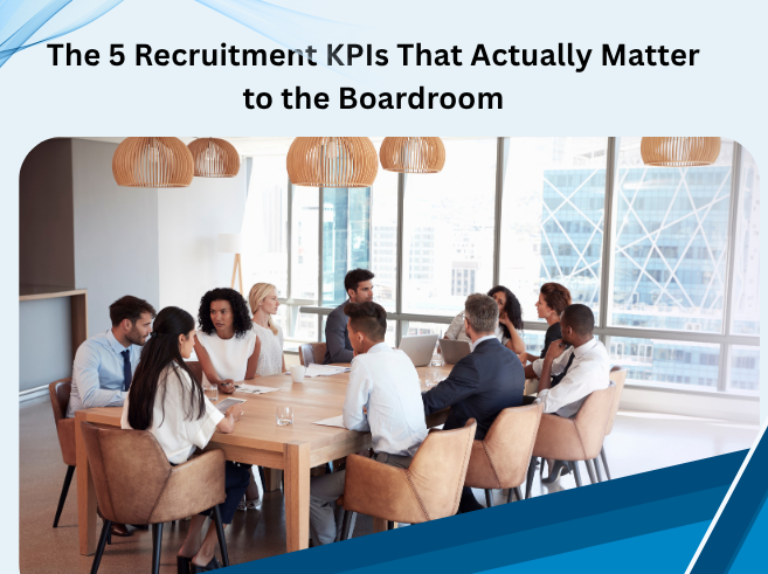Beyond Time-to-Hire: The 5 Recruitment KPIs That Actually Matter to the Boardroom

The False Prophets of Hiring Metrics
As a CEO or CFO, you’ve likely seen the classic HR dashboard metric: Time-to-Hire. It's the standard bearer of recruitment efficiency. But let’s be direct: Time-to-Hire is often a misleading metric that encourages rushing and sacrifices quality. A quick hire that lasts six months is a time sink, not a win.
The boardroom doesn't care how fast you found a candidate; it cares about how much revenue, innovation, and stability that person delivers.
It’s time to retire vanity metrics and adopt a Talent Scorecard that speaks the language of finance: Recruitment ROI, Profitability, and Risk Mitigation.
Here are the 5 Recruitment KPIs that your talent team should be presenting to the executive committee metrics that directly align with shareholder value.
KPI 1: Quality of Hire (QoH) - The True Measure of Value
Why it matters: This is the single most important metric. It directly measures the success of your Strategic Talent Acquisition efforts.
How to track it (The CEO's Formula): Instead of a subjective manager rating, calculate QoH based on a weighted average of hard data points 12 months after the start date:
QoH Score=(0.40×First-Year Performance Review Rating)+(0.30×365-Day Retention Rate)+(0.30×Ramp-Up Time Success)
A high QoH score proves your recruitment investment is paying off with productive, long-term talent.
KPI 2: The Cost of a Poor Hire (CoPH) - Quantifying the Risk
Why it matters: Every bad hire impacts productivity, morale, and consumes significant resources. CEOs need to see this as a measurable financial risk.
How to track it (The Financial Impact): CoPH includes tangible factors like severance pay, lost training costs, and recruitment fees, but also intangible costs like lost productivity for the team, management time spent on discipline, and the revenue gap created by the vacant seat. Tracking this KPI justifies premium Manpower Consultancy Services that ensure a better cultural and skill fit.
KPI 3: Ramp-Up Time to Full Productivity
Why it matters: This metric measures the efficiency of your onboarding process and the accuracy of the hire. The faster a new employee becomes fully productive, the faster they contribute to revenue.
How to track it (The Benchmarking): Define "full productivity" for each role (e.g., a Sales rep closing their first deal; an Engineer deploying their first major feature). Compare the actual time taken by the new hire against the expected benchmark time (e.g., 90 days). A consistent gap reveals flaws in your candidate screening or your internal training structure.
KPI 4: First-Year Attrition Rate (by Hiring Source)
Why it matters: High early attrition is a direct sign of a broken hiring or onboarding process. It highlights a critical retention risk that needs immediate management attention.
How to track it (The Source-of-Hire Analysis): Track the percentage of employees who leave within their first 12 months, breaking it down by where they came from (referral, job board, recruitment firm). This simple analysis reveals which Talent Strategy channels deliver genuinely committed, quality candidates. A low attrition rate for a specific source is an indicator of a Top Recruitment Agency partner.
KPI 5: Hiring Manager Satisfaction (The Alignment Metric)
Why it matters: Recruiting exists to serve the business, and the hiring manager is the primary client. Low satisfaction signals a profound misalignment between the talent team and operational needs.
How to track it (The Timely Feedback): Implement a mandatory 5-question survey for the hiring manager 30 days after the new employee starts. Questions should focus on process quality, candidate fit, and speed. Low scores are a warning sign that the recruiter may not fully understand the team's needs or that the job requirement itself is flawed.
The Final Word: From Process Watchers to Value Drivers
If your recruitment reports still focus only on volume and speed, you’re missing the forest for the trees. The modern Talent Strategy must be rooted in measurable business outcomes.
By tracking these 5 KPIs, you transition your HR function from a cost center to a predictive, strategic business partner. You gain the data needed to make high-stakes, long-term decisions about scaling, risk, and profitability.
Ready to build a data-driven talent team focused on Quality of Hire? Partner with us for a Strategic Talent Acquisition approach that delivers measurable business value from day one.


